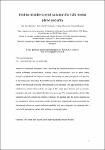End-to-middle-to-end solution for IMS media plane security
| dc.contributor.author | Fajardo, JO | |
| dc.contributor.author | Liberal, F | |
| dc.contributor.author | Li, F | |
| dc.contributor.author | Clarke, Nathan | |
| dc.contributor.author | Mkwawa, Is-Haka | |
| dc.date.accessioned | 2023-10-20T11:55:01Z | |
| dc.date.available | 2023-10-20T11:55:01Z | |
| dc.date.issued | 2019-09 | |
| dc.identifier.issn | 1389-5753 | |
| dc.identifier.issn | 1572-9362 | |
| dc.identifier.uri | https://pearl.plymouth.ac.uk/handle/10026.1/21475 | |
| dc.description.abstract |
IP multimedia subsystem (IMS) is becoming the prevailing candidate for managing future mobile multimedia communications, including critical communications such as public safety, emergency professionals and corporate networks. IMSsecurity and privacy has gained much attention in the few last years. The review of recent IMS security activities stresses the inclusion of intermediate nodes in the media path of secured communications as an open issue. This paper presents an end-to-middle-to-end solution which enables the usage of IMS media plane elements such as recorders, transcoders and novel cross-ciphering functions in a secure way. The proposed solution, which is fully compliant with IMS, includes the network architecture, the signaling plane for session signaling and key management, and the media-plane security characteristics. Experimental results demonstrate that the proposed solution can provide media interoperability (both transcoding and cross-ciphering) with a costof 17 % overhead to a standard IMS call setup in the signaling plane. | |
| dc.format.extent | 719-746 | |
| dc.language | en | |
| dc.publisher | Springer Science and Business Media LLC | |
| dc.subject | IMS | |
| dc.subject | Media plane security | |
| dc.subject | Cross-ciphering | |
| dc.subject | Security resource function | |
| dc.title | End-to-middle-to-end solution for IMS media plane security | |
| dc.type | Journal Article | |
| plymouth.author-url | https://www.webofscience.com/api/gateway?GWVersion=2&SrcApp=PARTNER_APP&SrcAuth=LinksAMR&KeyUT=WOS:000482479500011&DestLinkType=FullRecord&DestApp=ALL_WOS&UsrCustomerID=11bb513d99f797142bcfeffcc58ea008 | |
| plymouth.issue | 3 | |
| plymouth.volume | 19 | |
| plymouth.publication-status | Published | |
| plymouth.journal | Electronic Commerce Research | |
| dc.identifier.doi | 10.1007/s10660-019-09367-2 | |
| plymouth.organisational-group | |Plymouth | |
| plymouth.organisational-group | |Plymouth|Faculty of Science and Engineering | |
| plymouth.organisational-group | |Plymouth|Faculty of Science and Engineering|School of Engineering, Computing and Mathematics | |
| plymouth.organisational-group | |Plymouth|REF 2021 Researchers by UoA | |
| plymouth.organisational-group | |Plymouth|Users by role | |
| plymouth.organisational-group | |Plymouth|Users by role|Academics | |
| plymouth.organisational-group | |Plymouth|REF 2021 Researchers by UoA|UoA11 Computer Science and Informatics | |
| dc.date.updated | 2023-10-20T11:55:01Z | |
| dc.rights.embargodate | 2023-10-21 | |
| dc.identifier.eissn | 1572-9362 | |
| dc.rights.embargoperiod | ||
| rioxxterms.versionofrecord | 10.1007/s10660-019-09367-2 |


